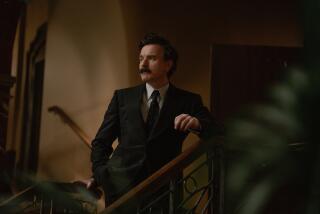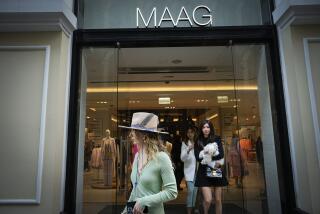Store Delivers Overnight : In Moscow, Helsinki Is Place to Shop
HELSINKI, Finland â Stockmannâs, the biggest department store in Helsinki, is known in Moscow--to those who can afford it--as Moscowâs best.
For diplomats, journalists and others in Moscow with hard currency to spend, Stockmannâs is a direct link to the capitalist world of things not available in the Communist state.
Every evening, the âTolstoy Expressâ rolls out of the Helsinki railroad station, with an attached baggage car full of goodies, on the overnight run to Moscow. In Moscow, the customers wait expectantly.
âYou send a telex to Stockmannâs and they send you the stuff in a couple of days,â a Westerner living in Moscow said the other day. âThey donât even bill you until later. Sometimes I wonder how we could live here otherwise.â
Catering Offered, Too
Stockmannâs offers more than just the essentials. It has a special catering service for embassy parties--everything from flowers, champagne and smoked salmon to paper napkins and toothpicks.
When Soviet leader Yuri V. Andropov died and the U.S. Embassy in Moscow needed a funeral wreath in a hurry, it called on Stockmannâs. The order was placed late in the day, and Stockmann artisans worked all night to create a huge wreath that was put on board the first train for Moscow.
The storeâs catalogue, illustrated and in color, is prized reading material in Moscow. It is to Stockmannâs customers there what the Sears, Roebuck catalogue was to rural Americans a generation or so ago.
Listed in it is virtually every need: fresh foodstuffs, delicatessen specialties, toiletries, baby care products, kitchenware, appliances, television sets, bathroom and bedding supplies, pet food, sportswear, wines, automobiles, books.
Photo Service
It offers jewelry and furs, too, and even a photo service.
Most heavily ordered by customers in Moscow is fresh food. Milk is the largest single item, for many Westerners in Moscow donât like the taste of the local product. The U.S. Embassy orders more than 2,000 quarts a week.
For couples with small children in Moscow, Stockmannâs makes life much easier. It ships in baby food, paper diapers and other such necessities.
Business is especially brisk in the holiday season, and for days the Tolstoy Express is loaded with gifts and, in the coals-to-Newcastle category, dozens of Christmas trees.
âStockmannâs is like Aladdinâs lamp,â a Russian who works for an American firm in Moscow said the other day. âRub it and it brings what you want. But you have to pay a lot for it.â
Prices are relatively high. Export firms in Scandinavia and West Germany can beat Stockmannâs prices, but they canât match the Helsinki store for speedy service.
The main problem for Stockmannâs non-diplomatic customers in Moscow lies with the Soviet customs officers, who are unpredictable about what import fees they will charge.
âOne day they might let a Patton tank go through without a hitch,â a customer in Moscow remarked, exaggerating a bit, âand the next theyâll stop a penknife. It depends on their mood.â
Diplomats generally have duty-free privileges, but for journalists and other unofficial Americans working in Moscow, import duties can be brutal.
âThey seem to make up the rates as they go along,â one journalist said. âThey can run from 10% to 25% and even more. It seems to be done on a hit-or-miss basis, and itâs always a surprise. There is supposed to be a list of fixed charges, but one never sees it, nor would it be wise to insist on seeing it. They would find other ways to charge you.
Wine Taxes Standard
âThe strange thing is that they weigh the wine that comes in, so they charge you the same duty for a $100 bottle of wine as for a $5 bottle.
âBut you donât have much choice. The whole point of ordering from Stockmannâs is to buy things that you simply cannot get in Moscow. So you must be prepared to pay.â
Soviet customs officers keep an eye out particularly for goods coming in that appear to be more than the customer needs for his or her personal use. These products are either turned back or a prohibitively high duty is levied.
âIf, say, 10 dresses turned up for one customer, they would really get nasty,â a Western woman in Moscow observed.
Stockmannâs was founded in 1862, when the German merchant G. F. Stockmann set up shop in the Finnish capital. In 1930, the store moved into its present landmark building in the center of the city.
In 1969, the Finnish architect Alvar Aalto designed an annex to house Stockmannâs Academic Bookstore, the second-busiest in Europe. It is a structural jewel, with an atrium surrounded by browsersâ shelves and tables and a skylight flooding the space with brightness.
8 Languages Used
Catalogue sales make up only a small part of Stockmannâs trade. Most of the storeâs business is with visitors to the main store and branches elsewhere in Finland. Shopping advice is offered in eight languages by salespersons wearing tiny flags to indicate the languages they speak.
In 1904, Stockmannâs sold the first motor car ever bought in Finland. Today, the company has two motor vehicle units--Ford and Nissan dealerships--plus a service garage for cars driven in from the Soviet Union.
Stockmannâs motto for customers in the Soviet Union is âIf we donât carry it, weâll get it for you.â
Director Hannu Penttila told an interviewer in his office: âOur sales to Moscow customers have become more important. They run to $5 million a year. We ship at 5 p.m. and itâs in Moscow at 9 a.m. the next morning. Thatâs why we can ship fresh foods like milk and salad greens. Perishables are packed in dry ice.â
Looking ahead, Penttila would like to develop outlets in the Soviet Union, but he says the Soviets insist on a 50-50 balance of trade with Finland.
âWe canât find enough products in Russia that you can sell to Western customers,â he said.
Still, they say in Moscow that you donât go shopping, you go searching, and Penttila would like to remedy that state of affairs. So the possibility of opening a Moscow branch is being studied despite the Soviet attitude.
âOn my last trip to Moscow,â Penttila said, âI was told that the state department store on Red Square, known as GUM, had yearly sales of 1.4 billion rubles. That would be about 10 billion Finnish marks ($2.5 billion) at the official rate of exchange, or 10% of the whole Finnish national budget. Just imagine what kind of business you could do with an outlet in Moscow, run like this store. It would be fantastic!â
More to Read
Inside the business of entertainment
The Wide Shot brings you news, analysis and insights on everything from streaming wars to production â and what it all means for the future.
You may occasionally receive promotional content from the Los Angeles Times.










